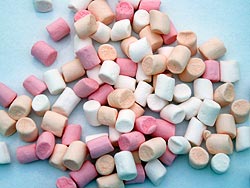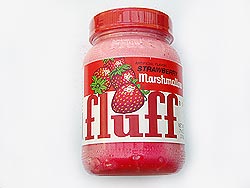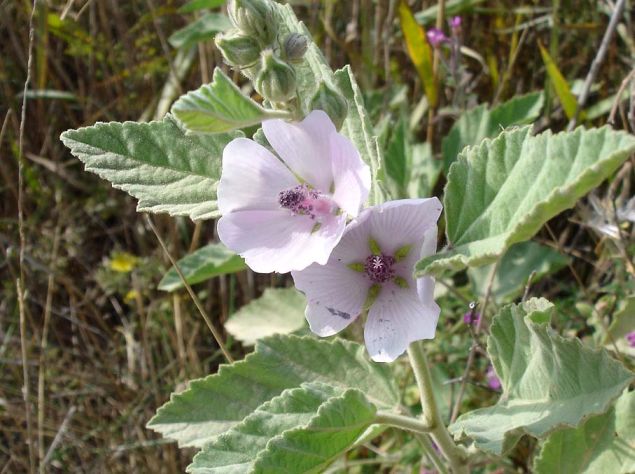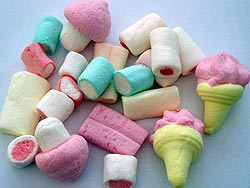Food-Info.net> Products > Sweets and Confectionary
Marshmallows
Marshmallows are sweets made of sugar or corn syrup, beaten egg whites, gelatin, gum arabic, colours and flavourings, whipped to a spongy consistency. The traditional recipe used an extract from the mucilaginous root of the marshmallow plant, a shrubby herb (Althaea officinalis), instead of gelatin. The use of this plant has given the name to the sweets, but nowadays the plant is no longer used for the production of marshmallows.

Mini Marshmallows (Source)
Sweets based on the juice of the marshmallow plant probably date to ancient times. There are indications that the Egyptians and the Romans used sweets made with marshmallow roots and honey. Commercial marshmallows are a late 19th century innovation
Marshmallows are popular with children and adults alike, and are eaten with or without accompaniments. In the United States and elsewhere, marshmallows are frequently dipped or melted in hot chocolate or coffee.
A popular, traditional US treat is created by toasting marshmallows over an open flame. A marshmallow is placed on the end of a stick or skewer and heated briefly. This creates a caramelized outer skin with a liquid, melted layer underneath. Either the toasted marshmallow can be eaten whole or the outside layer can be consumed separately and the marshmallow toasted again.
Another US specialty is Marshmallow cream or marshmallow fluff, a very sweet spreadable, marshmallow-like product, which is popular amongst young children.

Marshmallow fluff (Source)
Marshmallow plant
The Marshmallow (Marsh Mallow, or Common Marshmallow), Althaea officinalis is a shrub native to most of Europe. The plant grows up to 1 m high. The leaves and the roots of the plant have been used as foods since ancient times.

Althea officinalis (Source)
The roots are characterised by a rather thick layer of mucilage. The contents of mucilage in roots varies between 20 and 30 %, with an additional 10-15% of pectin.
The heavily branched structure of mucilage is composed of D-galactose, L-rhamnose, D-glucuronic acid and D-galacturonic acid. The structure resembles the structure of pectin, which explains the thickening properties of the mucilage and its original use in the sweets.
Production
The first step of the production of marshmallows is to mix all the ingredients to a foamy mixture.
This mixture is extruded as soft cylinders, cut in sections and rolled in a mix of finely powdered cornstarch and confectioner's sugar. When specific shapes are needed, a different nozzle can be placed on the extruder.
During the extrusion process the mixture solidifies into the spongy texture of marshmallows.

Different marshmallow shapes (Source)
Historically the mucilage of the marshmallow plant was used as a thickening agent. Nowadays this has been replaced by gelatin and/or gum Arabic. Marshmallows for vegans are made using carragenan and agar as gelling agents instead of gelatin.
References :
- Capek P, et al. Polysaccharides from the root of the marsh mallow (Althaea officinalis L., var. Rhobusta): structural features of an acidic polysaccharide. Carbohydrate Research 1987; 164: 443-452.
- Capek P, et al. Polysaccharides from the roots of the marsh mallow (Althaea officinalis L.): structure of an arabinan. Carbohydrate Research 1983; 117: 133-140.
- Capek P, et al. Polysaccharides from the roots of Althaea officinalis L.: structural features of D-glucans. Collection Czechoslovak Chem. Commun.1984; 49: 2674-2679.
- Tomoda M, et al. Plant Mucilages XXIV. The structural features of Althaea-mucilage O, a representative mucous polysaccharide from the roots of Althaea officinalis Chem Pharm Bull 1980; 28 (3); 824-830.




